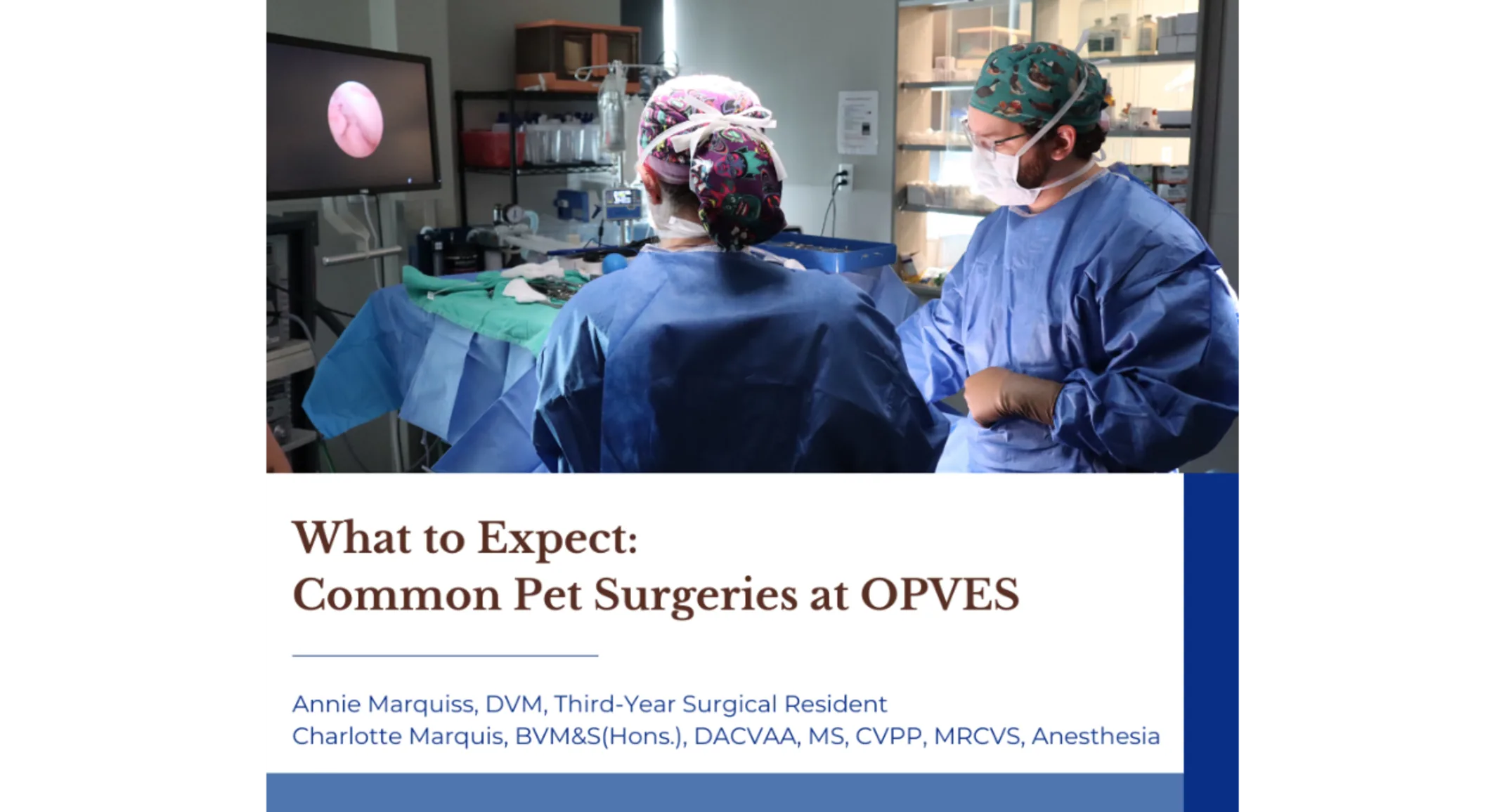What to Expect: Common Pet Surgeries at OPVES
December 6, 2024 · Veterinary Services

At OPVES, we understand how stressful it can be when your pet needs surgery. To help you feel informed and confident, we've outlined the most common procedures we perform, what you can expect before, during, and after surgery, and how our team works to ensure your pet's safety and comfort.
Common Pet Surgeries We Perform
1. Orthopedic Surgeries:
TPLO (Tibial Plateau Leveling Osteotomy): Restores knee stability after cranial cruciate ligament injury, improving mobility and comfort.
Fracture Repair: Aligns broken bones for proper healing, offering better outcomes than splinting.
Luxating Patella Repair: Stabilizes the kneecap for enhanced mobility and reduced cartilage wear.
Arthrodesis: Fuses painful or severely damaged joints to improve quality of life.
2. Neurological Surgeries:
IVDD (Intervertebral Disc Disease) Surgery: Relieves spinal cord pressure, alleviating pain and restoring function.
3. Soft Tissue and Reconstructive Surgeries:
Femoral Head and Neck Osteotomy (FHO): Creates a false joint to relieve hip pain and improve limb use.
Laparoscopic Spay and Gastropexy: Minimally invasive options for spaying and preventing gastric torsion.
Brachycephalic Airway Surgery: Improves breathing for breeds like Bulldogs and Pugs.
4. Emergency and Specialized Surgeries:
Splenectomy: Removes the spleen to prevent life-threatening bleeding from masses.
Foreign Body Surgery: Resolves dangerous gastrointestinal blockages.
Cesarian Section: Safeguards moms and their babies during difficult deliveries.
Amputation: Alleviates pain from severe injuries or cancer, with most pets adapting well to three legs.
The Role of Our Anesthesiologist
Our anesthesiologist, Dr. Charlotte Marquis, plays a vital role in your pet's surgical care:
Pre-Surgical Assessment: Designs an anesthesia plan tailored to your pet’s health and needs.
Anesthesia Monitoring: Ensures your pet's safety with advanced monitoring techniques.
Pain Management: Provides nerve blocks, epidurals, and more to keep your pet comfortable.
Team Approach: Collaborates with surgeons and specialists for optimal care.
Preparing for Surgery
1. Pre-Surgical Exams and Diagnostics: Blood work and imaging are often recommended to evaluate your pet's health and plan for surgery.
2. Owner Preparation:
Follow fasting instructions to prevent complications.
Discuss medications with your surgeon, as some may need adjustment.
Avoid grooming or bathing your pet close to the surgery date.
What to Expect During Surgery
The Surgical Team: A collaborative team of specialists ensures your pet’s care is seamless.
Anesthesia and Pain Management: Your pet’s comfort is prioritized throughout the procedure.
Procedure Duration: Surgery times vary but will be communicated to you in advance.
Recovery and Post-Surgery Care
1. Immediate Care: After surgery, your pet may experience temporary grogginess or limited mobility. Most pets stay overnight for monitoring.
2. At-Home Care Instructions:
Restrict activities to promote healing.
Prevent incision licking with an E-collar.
Follow medication and wound-care instructions.
3. Recovery Timelines:
Orthopedic surgeries like TPLO or fracture repair: ~8–12 weeks.
Abdominal procedures: ~2 weeks.
Amputation: ~2–3 weeks.
Frequently Asked Questions
Will my pet be in pain? Advanced pain management techniques ensure your pet’s comfort.
Can my pet regain full mobility? Most pets recover well with time, care, and activity adjustments.
Conclusion
Surgery can greatly improve your pet’s quality of life. Our team is here to guide you through every step, from consultation to recovery. If you have any questions or concerns, don’t hesitate to reach out. Together, we’ll ensure your pet gets the best possible care.
